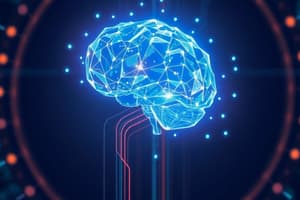Podcast
Questions and Answers
What is the first step in the K-Means Clustering algorithm?
What is the first step in the K-Means Clustering algorithm?
Calculate the number of K (clusters).
How are the initial cluster centers selected in the K-Means algorithm?
How are the initial cluster centers selected in the K-Means algorithm?
They are randomly selected from the data points.
What formula is used to measure the distance between data points and cluster centers?
What formula is used to measure the distance between data points and cluster centers?
The Euclidean distance formula is used.
What is the significance of re-computing the cluster centers in K-Means?
What is the significance of re-computing the cluster centers in K-Means?
What are the stopping criteria for the K-Means algorithm?
What are the stopping criteria for the K-Means algorithm?
How do you compute the distance between a data point and a centroid in cluster analysis?
How do you compute the distance between a data point and a centroid in cluster analysis?
What is the new centroid of Cluster 1 if the original points are P1(1,3), P2(2,2), and P7(3,3)?
What is the new centroid of Cluster 1 if the original points are P1(1,3), P2(2,2), and P7(3,3)?
After Iteration 1, what were the coordinates of the new centroids for all three clusters?
After Iteration 1, what were the coordinates of the new centroids for all three clusters?
Explain why it is necessary to re-compute clusters after calculating new centroids.
Explain why it is necessary to re-compute clusters after calculating new centroids.
What distance did you calculate between P1(1,3) and C1(2,2.7)?
What distance did you calculate between P1(1,3) and C1(2,2.7)?
Flashcards are hidden until you start studying
Study Notes
Introduction to Machine Learning Ethics
- Machine learning ethics is the application of ethical principles to the development, deployment, and use of ML algorithms.
- ML systems impact decision-making in sensitive areas, such as healthcare, law, and finance, with the potential for harm, bias, or discrimination.
Risks and Ethical Challenges in Machine Learning
- Balancing innovation with ethical concerns like privacy, transparency, and fairness is critical.
- Example: Target Case (2012) - Target used machine learning to predict when women were pregnant, leading to privacy invasions and exposing sensitive information unintentionally.
- ML systems are susceptible to adversarial attacks, where imperceptible changes to input data can lead to incorrect predictions.
- Example: Adding a few pixels to an image can cause an autonomous vehicle to misidentify a stop sign.
- Automated decision-making systems raise concerns about human oversight in critical scenarios like medical diagnosis, loan approvals, and autonomous weapons.
- Example: Autonomous weapons systems may make lethal decisions without human input, creating moral and ethical challenges.
Key Ethical Principles
- Transparency: How the system works should be clear and understandable.
- Fairness: The system should treat people equally and avoid bias.
- Accountability: The system should be responsible for its decisions, and mechanisms for redress should be in place.
- Privacy: The system should respect people's privacy and protect their personal data.
- Safety & Security: The system should be designed to be safe and secure, and protected from malicious attacks.
Regulatory and Legal Frameworks
- GDPR (EU): Emphasizes data privacy and protection, with specific rules about automated decision-making.
- EU AI Act: Regulates AI based on the risk posed, with different rules for high-risk and low-risk AI systems.
- Future of AI Regulation: Ongoing efforts are underway to create global standards for ethical AI development.
Practical Use Cases
Healthcare
- AI in Medical Diagnosis: Machine learning models analyze medical images to detect diseases.
- Ethical Risk: Bias in training data can lead to unequal healthcare outcomes.
- Mitigation Strategy: Ensure training data is representative of diverse patient populations.
Autonomous Vehicles
- AI in Self-Driving Cars: Machine learning enables cars to make real-time driving decisions.
- Ethical Risk: AI systems face ethical dilemmas in accident scenarios regarding who to prioritize.
- Mitigation Strategy: Ethical decision-making frameworks should be developed for autonomous vehicles, ensuring human values are integrated into their programming.
Recruitment and Hiring
- AI in Hiring: Companies use AI systems to screen resumes, schedule interviews, and evaluate candidates.
- Ethical Risk: If training data is biased, AI systems may perpetuate discriminatory hiring practices.
- Mitigation Strategy: Regular audits and bias testing of hiring algorithms are crucial.
Best Practices for Mitigating Risks
- Bias Audits: Regularly check algorithms for potential bias in predictions.
- Explainability Tools: Use techniques like LIME (Local Interpretable Model-Agnostic Explanations) or SHAP (Shapley Additive Explanations) to make ML models more interpretable.
- Privacy-Preserving Techniques: Implement technologies like differential privacy, homomorphic encryption, federated learning, and hybrid approaches to protect privacy.
- Human-in-the-Loop: Ensure that human oversight remains a key part of AI decision-making processes.
Conclusion
- Ethical machine learning prioritizes balancing innovation with responsibility, fairness, and accountability.
- As AI systems become more complex, continued focus on ethics, updated regulations, and a culture of responsibility in AI development will be essential.
Studying That Suits You
Use AI to generate personalized quizzes and flashcards to suit your learning preferences.




